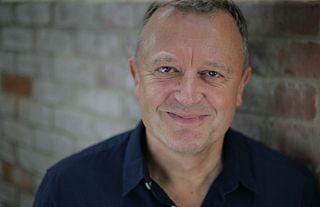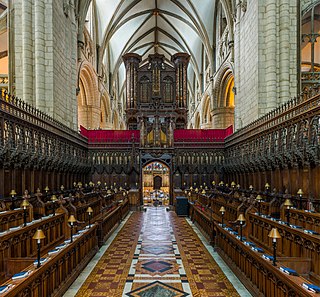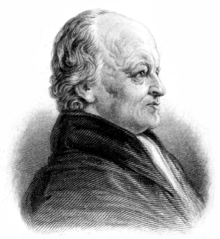
Orchestration is the study or practice of writing music for an orchestra or of adapting music composed for another medium for an orchestra. Also called "instrumentation", orchestration is the assignment of different instruments to play the different parts of a musical work. For example, a work for solo piano could be adapted and orchestrated so that an orchestra could perform the piece, or a concert band piece could be orchestrated for a symphony orchestra.

Sir John Kenneth Tavener was an English composer, known for his extensive output of choral religious works. Among his best known works are The Lamb (1982), The Protecting Veil (1988), and Song for Athene (1993).
A chord is in close harmony if its notes are arranged within a narrow range, usually with no more than an octave between the top and bottom notes. In contrast, a chord is in open harmony if there is more than an octave between the top and bottom notes. The more general term spacing describes how far apart the notes in a chord are voiced. A triad in close harmony has compact spacing, while one in open harmony has wider spacing.

Sir John Milford Rutter is an English composer, conductor, editor, arranger, and record producer, mainly of choral music.
In Classical music theory, a Neapolitan chord is a major chord built on the lowered (flatted) second (supertonic) scale degree. In Schenkerian analysis, it is known as a Phrygian II, since in minor scales the chord is built on the notes of the corresponding Phrygian mode.

"Frühlingsstimmen", Op. 410 is an orchestral waltz, with optional solo soprano voice, written in 1882 by Johann Strauss II.

"The Tyger" is a poem by the English poet William Blake, published in 1794 as part of his Songs of Experience collection and rising to prominence in the romantic period. The poem is one of the most anthologised in the English literary canon, and has been the subject of both literary criticism and many adaptations, including various musical versions. The poem explores and questions Christian religious paradigms prevalent in late 18th century and early 19th century England, discussing God's intention and motivation for creating both the "Lamb" and the eponymous "Tyger."

"The Lamb" is a poem by William Blake, published in Songs of Innocence in 1789.

Patrick Hawes is a British composer, conductor, organist and pianist.

Songs of Innocence and of Experience is a collection of illustrated poems by William Blake. Originally, Blake illuminated and bound Songs of Innocence and Songs of Experience separately. It was only in 1794 that Blake combined the two sets of poems into a volume titled Songs of Innocence and of Experience Shewing the Two Contrary States of the Human Soul. Even after beginning to print the poems together, Blake continued to produce individual volumes for each of the two sets of poetry.

Agnus Dei(Lamb of God) is a choral composition in one movement by Samuel Barber, his own arrangement of his Adagio for Strings (1936). In 1967, he set the Latin words of the liturgical Agnus Dei, a part of the Mass, for mixed chorus with optional organ or piano accompaniment. The music, in B-flat minor, has a duration of about eight minutes.
"Bethlehem Down" is a Christmas carol for SATB choir composed in 1927 by British composer Peter Warlock (1894–1930)—the pseudonym of Philip Arnold Heseltine. It is set to a poem written by journalist and poet Bruce Blunt (1899–1957). Warlock and Blunt wrote the carol to finance an "immortal carouse" over Christmas in 1927. The pair submitted the carol to The Daily Telegraph's annual Christmas carol contest and won. It is characterised by modal harmony with chromatic inflections. The musicologist Barry Smith described "Bethlehem Down" as the finest of all of Warlock's choral music.
"Song for Athene" is a musical composition by British composer John Tavener with lyrics by Mother Thekla, an Orthodox nun, which is intended to be sung a cappella by a four-part choir. It is Tavener's best known work, having been performed by the Westminster Abbey Choir conducted by Martin Neary at the funeral service of Diana, Princess of Wales, on 6 September 1997 as her cortège departed from Westminster Abbey.
La fille aux cheveux de lin is a musical composition for solo piano by French composer Claude Debussy. It is the eighth piece in the composer's first book of Préludes, written between late 1909 and early 1910. The title is in French and translates roughly to "The Girl with the Flaxen Hair". The piece is 39 measures long and takes approximately two and a half minutes to play. It is in the key of G♭ major.
"The Lord bless you and keep you" is a classical sacred choral composition by John Rutter, based on Numbers 6:24-26. It is a setting of a biblical benediction, followed by an extended "Amen". Rutter scored the piece for four vocal parts (SATB) and organ. He composed it in 1981 for the memorial service of Edward T. Chapman, the director of music at Highgate School, London, with whom he had studied when he attended the school.

The Magnificat by John Rutter is a musical setting of the biblical canticle Magnificat, completed in 1990. The extended composition in seven movements "for soprano or mezzo-soprano solo, mixed choir, and orchestra " is based on the Latin text, interspersed with "Of a Rose, a lovely Rose", an anonymous English poem on Marian themes, the beginning of the Sanctus and a prayer to Mary. The music includes elements of Latin American music.

Songs of Innocence and Experience is an album by American beat poet and writer Allen Ginsberg, recorded in 1969. For the recording, Ginsberg sang pieces from 18th-century English poet William Blake's illustrated poetry collection of the same name and set them to a folk-based instrumental idiom, featuring simple melodies and accompaniment performed with a host of jazz musicians. Among the album's contributors were trumpeter Don Cherry, arranger/pianist Bob Dorough, multi-instrumentalist Jon Sholle, drummer Elvin Jones, and Peter Orlovsky – Ginsberg's life-partner and fellow poet – who contributed vocals and helped produce the recording with British underground writer Barry Miles.

The Magnificat and Nunc dimittis for Gloucester Cathedral, also known as the Gloucester Service, is a setting by the English composer Herbert Howells of the Magnificat and Nunc dimittis for the Anglican service of Evensong. Scored for four-part choir and organ, it was written in 1946 for Gloucester Cathedral. It was published by Novello in 1947.
"For the beauty of the earth" is a sacred choral composition by John Rutter, a setting of the hymn of the same name by Folliott S. Pierpoint. The work was published by Oxford University Press in 1980. Recorded several times, it has been described as "one of Rutter's more popular, enduring anthems".
Mother and Child is a choral composition by John Tavener written in 2002 on a commission from the Tenebrae vocal ensemble. The lyrics were written by Brian Keeble. The music is set for a choir in up to nine vocal parts, organ and temple gong. The duration is about 10 minutes. The composition was first recorded by Tenebrae in 2003 on an album of the same name, conducted by Nigel Short. The work was published by Chester Music in 2004.












